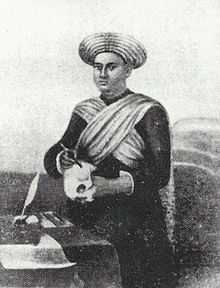Pandit Madhusudan Gupta | |
|---|---|
| মধুসূদন গুপ্ত | |
 | |
| Born | 1800 |
| Died | 15 November 1856 (aged 55–56) |
| Education | The Sanskrit College and University |
| Occupation | Doctor |
| Known for | First human dissection in India under Western medicine |
| Medical career | |
| Institutions | Calcutta Medical College and Hospital |
| Sub-specialties | Ayurveda, anatomy |
| Research | Puberty |
| Notable works | Translation of Anatomists Vade-mecum |
Pandit Madhusudan Gupta (Bengali: মধুসূদন গুপ্ত) (1800 – 15 November 1856) was a Bengali Baidya Brahmin translator and Ayurvedic practitioner who was also trained in Western medicine and is credited with having performed India's first human dissection at Calcutta Medical College (CMC) in 1836, almost 3,000 years after Susruta.
Born into a Baidya Brahmin family, he studied Ayurvedic medicine at the Sanskrit College and progressed to teacher. Here, he began translations of a number of English texts into Sanskrit, including Hooper's Anatomists’ Ved-mecum. In addition, he attended anatomy and medicine lectures, becoming familiar with the developing clinical-anatomical medicine of Europe.
In 1835, he was transferred to the new CMC, where he was fundamental in gathering Indian support for practical anatomy and in breaking down Hindu taboos on touching the dead, consequently taking sole responsibility for the first human dissection, performed under the guidance of Professor Henry Goodeve and assisted by four other Hindu students. Controversies regarding the exact date of the first procedure, whether other students had performed it before and whether a military salute was given, remain. Despite any discrepancies, this singular act of dissection has become symbolic of the move of western medicine into India.
As a practitioner, he was successful and well regarded amongst his Indian contemporaries as well as by his European colleagues. In 1837, his involvement with the General Committee of the Fever Hospital and Municipal Improvements included recommendations for Kolkata's sanitation, a plead for better maternal care and a commendation to the smallpox vaccinators of Kolkata. His contributions to the research on puberty helped dismiss myths about the discrepancy of menarche between Indian and British women.
Gupta died from diabetic septicaemia in 1856, at the age of 56.